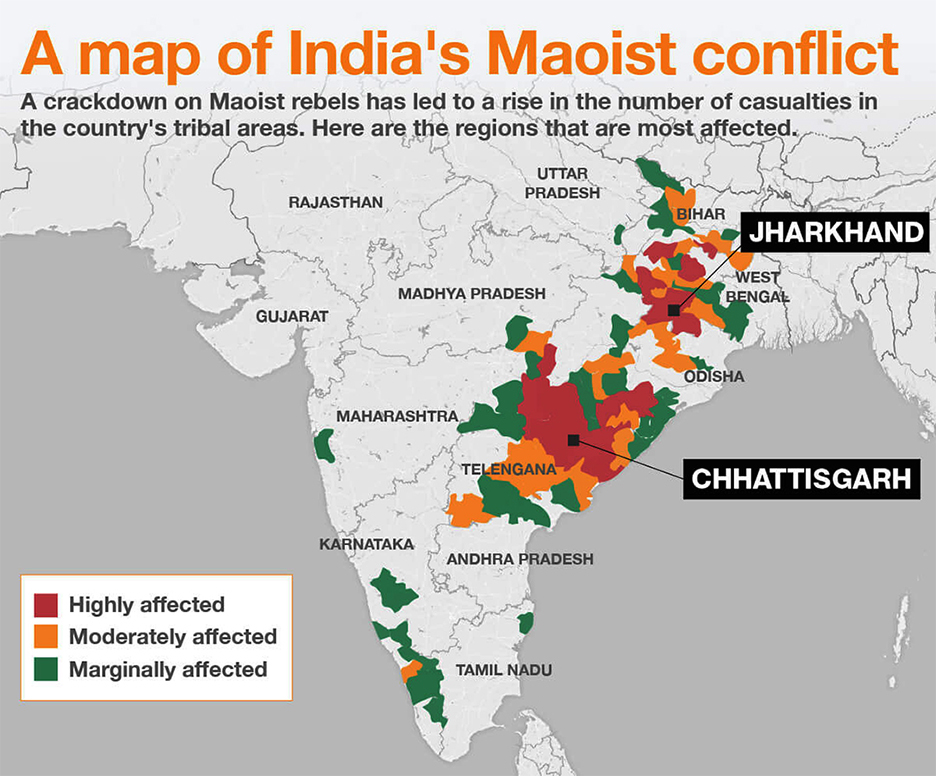-
21 Mar 2025
GS Paper 3
Internal Security
Day 95: The 'Red Corridor' is not just a security threat, but a governance failure. Examine. (150 words)
Approach
- Define the 'Red Corridor' and its significance in the context of Naxalism in India.
- Asses the Red Corridor as a Security Threat
- Explain how Governance Failures Contributing to Naxalism.
- Suggest a suitable way forward and provide an appropriate conclusion.
Introduction
The Red Corridor refers to the regions in India significantly affected by Left-Wing Extremism (LWE), led primarily by Naxalite groups. These areas span multiple states, including Chhattisgarh, Jharkhand, Odisha, Bihar, and parts of Maharashtra and Andhra Pradesh. While the insurgency is often seen as a serious security challenge, its persistence over decades indicates a deeper failure in governance, socio-economic justice, and rights delivery.
Body
Understanding the Red Corridor as a Security Threat
- Violence and Insurgency: Naxalites employ guerrilla warfare, ambushes, and landmines to attack security forces and disrupt state functioning.
- Major Attacks:
- Dantewada attack (2010): 76 CRPF personnel killed in Chhattisgarh.
- Sukma attack (2017): 25 CRPF jawans killed.
- Major Attacks:
- Undermining Democratic Institutions: Naxalites aim to establish a parallel administration through violence and coercion.
- Elected representatives are frequently targeted, reducing governance effectivenes.
- Naxalites establish "Janatana Sarkars" (People’s Governments), imposing their own tax and judicial systems, directly challenging state authority.
- Hindrance to Economic Development: Infrastructure projects such as highways, bridges, and schools are attacked to prevent state presence.
- Extortion (known as "revolutionary taxes") deters industries from investing.
- Mining and industrial projects are stalled, leading to economic stagnation.
Governance Failures Contributing to Naxalism
- Economic Deprivation and Inequality: Poverty levels in LWE-affected areas are significantly higher than the national average.
- Naxalism thrives in underdeveloped regions with high poverty rates.
- With no employment or industrialization, the youth remain vulnerable to recruitment by Naxal groups.
- Land and Forest Rights Issues: Land alienation and displacement due to mining projects, industrialization, and deforestation have particularly affected tribal communities.
- The failure to fully implement the Forest Rights Act, 2006, which grants tribals the right to manage and access forests, exacerbates their alienation.
- Exploitation by Powerful Entities: Tribal communities are frequently exploited by landlords, moneylenders, and mining companies.
- Naxalites position themselves as protectors against this exploitation, gaining support from those affected.
- Weak Governance and Lack of Infrastructure: Naxalism is prevalent in areas with weak government presence and inadequate infrastructure, such as poor roads and communication networks.
- This allows Naxalites to operate with relative ease and minimal interference.
Way Forward
- Strengthening Governance and Inclusive Development
- Adopt Multi-Dimensional Approach: Adopt a comprehensive strategy that combines socio-economic development, dialogue, and targeted military action.
- SAMADHAN strategy is a comprehensive approach by the Indian government to combat left-wing extremism.
- Improve Last-Mile Delivery: Ensuring direct benefit transfers (DBT) to reduce leakages in welfare schemes.
- Tribal Rights Protection:
- Strengthening Gram Sabhas to give local communities more say in land and forest decisions.
- Fast-tracking land rights under the Forest Rights Act, 2006.
- Fair Land Acquisition Policies:
- Ensuring proper compensation and rehabilitation for displaced communities.
- Adopt Multi-Dimensional Approach: Adopt a comprehensive strategy that combines socio-economic development, dialogue, and targeted military action.
- Holistic Counter-Insurgency Strategy
- Surrender and Rehabilitation Programs:
- Expansion of the "Surrender-cum-Rehabilitation Scheme", which offers ₹5 lakh financial aid for surrendered Naxalites.
- Focus on Education and Skill Development:
- Increasing vocational training centers in LWE-affected regions to reduce youth radicalization.
- Surrender and Rehabilitation Programs:
- Community Engagement and Civil Society Participation
- Empowering Self-Help Groups (SHGs): Promoting women-led cooperative movements.
- Countering Extremist Propaganda: Using media, local influencers, and social initiatives to promote peace narratives.
Conclusion
Development should be the first line of defense against Naxalism. Decades of economic neglect, land alienation, political exclusion, and lack of basic services have fueled Naxalism. A long-term solution requires a balanced approach, integrating effective governance, economic development, and targeted security measures.





